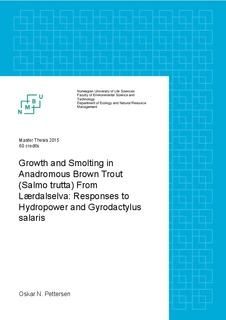| dc.description.abstract | Lærdalselva has faced many environmental alterations caused by anthropogenic activity over the last
four decades. This study has categorized these into four different treatment periods: “Before
hydropower ” (1954-1974), “After hydropower” (1974-1996), “Hydropower, Gyrodactylus salaris
and Gyrodactylus salaris treatments” (1996-2011) and “present times” (2012-2014). The objective of
this study was to determine if these treatment periods have imposed growth alternations and altered
age- and size at smolting in the anadromous brown trout population (Salmo trutta L.) of Lærdalselva.
These objectives were analyses using scale analyses of scales sampled from all treatment periods.
From the scale readings, freshwater- and sea age as well as age at smolting were determined at
individual level along with back-calculated sizes at all ages. These size-at-age and smolting trajectory
data were subjected to statistical analyses designed for elucidating the research objectives.
There were no significant differences in May-October mean water temperature among treatment
periods. The May-October mean water discharge has changed significantly among treatment periods,
with less water discharge after hydropower.
Back-calculated length at first year was significant reduced after launching hydropower compared to
the preceding period. Back-calculated specific growth rate during second year in freshwater, showed
no evidence of treatment period effect. There was a positive correlation between summer low-water
discharge and second-year specific growth rate. There has been a significant shift in smolt reaction
norms (SRN) where the anadromous brown trout during the hydropower period delayed smolting by
almost a year and larger size than during the preceding period. During the more recent periods, the
SRN has gradually shifted towards the original pattern. The marine growth has changed significantly
among the treatment periods. First sea year back-calculated specific growth rate has significantly
declined during the period after hydropower compared to the preceding period. However, Second-seayear
back-calculated specific growth rate has significantly improved after hydropower when compared
to the before period. For the hydropower, G. salaris and G. salaris treatment period, a decline in
second-sea-year back-calculated specific growth rate was found – after correcting for the positive
effect of mean summer air temperature. My study indicates that the anadromous brown in Lærdalsleva
is capable of rapid adaptions to anthropogenic-induced environmental change. | nb_NO |
